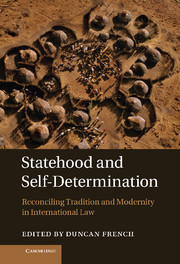32 results
17 - SDG 17: Strengthen the Means of Implementation and Revitalize the Global Partnership for Sustainable Development
-
-
- Book:
- The Cambridge Handbook of the Sustainable Development Goals and International Law
- Published online:
- 23 September 2022
- Print publication:
- 08 September 2022, pp 422-442
-
- Chapter
- Export citation
9 - Comments
- from Part III - Epilogue
-
-
- Book:
- The Prospects of Common Concern of Humankind in International Law
- Published online:
- 04 May 2021
- Print publication:
- 13 May 2021, pp 431-446
-
- Chapter
- Export citation
Russell Buchan, Cyber Espionage and International Law, Hart Publishing, 2018, 248pp, ISBN 9781782257363, £75.60
-
- Journal:
- Leiden Journal of International Law / Volume 32 / Issue 4 / December 2019
- Published online by Cambridge University Press:
- 07 August 2019, pp. 883-885
- Print publication:
- December 2019
-
- Article
- Export citation
Megalith quarries for Stonehenge's bluestones
-
- Article
-
- You have access
- HTML
- Export citation
21 - International Environmental Law*
- from Part II - Contextual Perspectives
-
-
- Book:
- Conceptual and Contextual Perspectives on the Modern Law of Treaties
- Published online:
- 19 October 2018
- Print publication:
- 25 October 2018, pp 677-709
-
- Chapter
- Export citation
Temporal and farm-management-associated variation in faecal-pat prevalence of Campylobacter fetus in sheep and cattle
-
- Journal:
- Epidemiology & Infection / Volume 142 / Issue 6 / June 2014
- Published online by Cambridge University Press:
- 25 September 2013, pp. 1196-1204
-
- Article
-
- You have access
- HTML
- Export citation

Statehood and Self-Determination
- Reconciling Tradition and Modernity in International Law
-
- Published online:
- 05 March 2013
- Print publication:
- 21 February 2013
Preface
-
- Book:
- Statehood and Self-Determination
- Published online:
- 05 March 2013
- Print publication:
- 21 February 2013, pp xvii-xx
-
- Chapter
- Export citation
Part II - Self-determination
-
- Book:
- Statehood and Self-Determination
- Published online:
- 05 March 2013
- Print publication:
- 21 February 2013, pp 227-426
-
- Chapter
- Export citation
Statehood and Self-Determination - Half title page
-
- Book:
- Statehood and Self-Determination
- Published online:
- 05 March 2013
- Print publication:
- 21 February 2013, pp i-ii
-
- Chapter
- Export citation
Contents
-
- Book:
- Statehood and Self-Determination
- Published online:
- 05 March 2013
- Print publication:
- 21 February 2013, pp v-vii
-
- Chapter
- Export citation
Copyright page
-
- Book:
- Statehood and Self-Determination
- Published online:
- 05 March 2013
- Print publication:
- 21 February 2013, pp iv-iv
-
- Chapter
- Export citation
Part III - Tradition, opportunities and challenges: the changing nature of the state
-
- Book:
- Statehood and Self-Determination
- Published online:
- 05 March 2013
- Print publication:
- 21 February 2013, pp 427-512
-
- Chapter
- Export citation
Part I - Statehood and recognition
-
- Book:
- Statehood and Self-Determination
- Published online:
- 05 March 2013
- Print publication:
- 21 February 2013, pp 21-226
-
- Chapter
- Export citation
List of principal abbreviations
-
- Book:
- Statehood and Self-Determination
- Published online:
- 05 March 2013
- Print publication:
- 21 February 2013, pp xlvii-l
-
- Chapter
- Export citation
Index
-
- Book:
- Statehood and Self-Determination
- Published online:
- 05 March 2013
- Print publication:
- 21 February 2013, pp 513-534
-
- Chapter
- Export citation
Table of treaties and major documents
-
- Book:
- Statehood and Self-Determination
- Published online:
- 05 March 2013
- Print publication:
- 21 February 2013, pp xxvi-xlvi
-
- Chapter
- Export citation
Table of cases
-
- Book:
- Statehood and Self-Determination
- Published online:
- 05 March 2013
- Print publication:
- 21 February 2013, pp xxi-xxv
-
- Chapter
- Export citation
Contributors
-
-
- Book:
- Statehood and Self-Determination
- Published online:
- 05 March 2013
- Print publication:
- 21 February 2013, pp viii-xiv
-
- Chapter
- Export citation
Statehood and Self-Determination - Title page
-
-
- Book:
- Statehood and Self-Determination
- Published online:
- 05 March 2013
- Print publication:
- 21 February 2013, pp iii-iii
-
- Chapter
- Export citation



